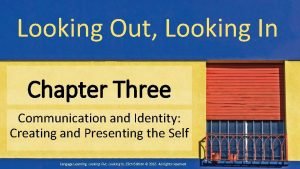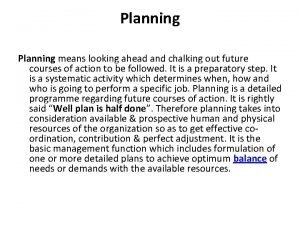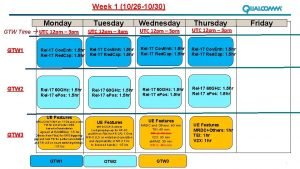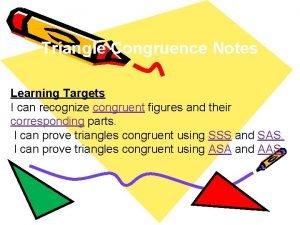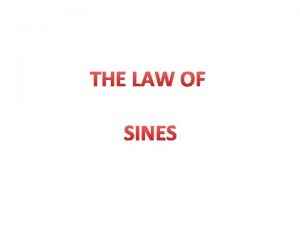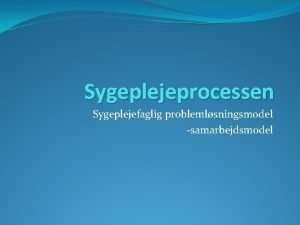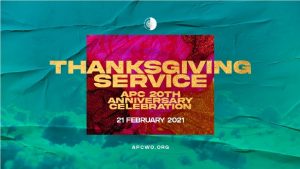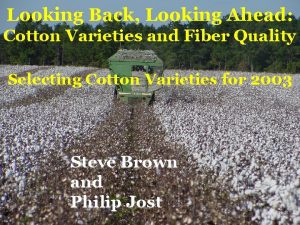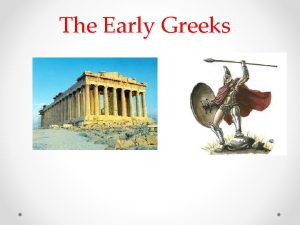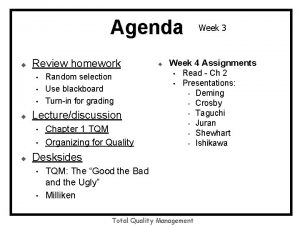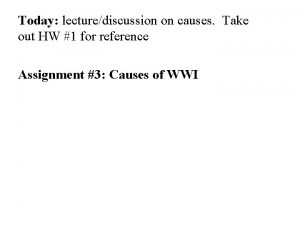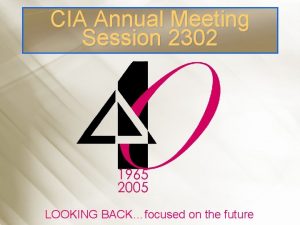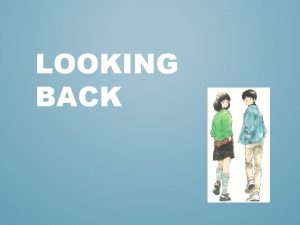SSA 2302 Looking Ahead Tuesday 1030 LectureDiscussion Chapter

























- Slides: 25

SSA 2302 – Looking Ahead • Tuesday 10/30 • Lecture/Discussion – Chapter 13 • Thursday 11/1 • Lecture/Discussion – Chapter 14 • DUE = Sport Industry Profile (upload to Canvas) • Assigned = Group #1 Reflection #2 (DUE = 11/8) • Tuesday 11/6 • Lecture/Discussion – Chapter 15 Exam #3 = Tuesday 11/13

CHAPTER 13 Sport Consumer Behavior Andrea N. Geurin, Cara Wright, and James J. Zhang

Understanding Sport Consumers • Knowing your customers: • What they want • What they need • What they think • What they feel • What they know • What they value

Understanding Sport Consumers • The more a sport organization knows about their consumers, the better it is able to: 1. Design products and services to meet the needs of customers 2. Design marketing messages that attract new customers and retain existing customers 3. Target messages to those most likely to be receptive to them

Understanding the Individual as a Sport Consumer • Common practice is to try to group people based on common characteristics • Segmentation • Segmenting sport consumers based on their demographics, motives, perceptions, and attitudes • Market segments: a portion of the population that is distinctive in terms of its needs, characteristics, or behavior • Target segments: market segment(s) identified as the focus of an organization’s marketing efforts

Market Segmentation • Psychographics ØLifestyles, activities, interests and opinions • These attributes may be influenced and change more readily than most demographic information • A 35 -year old male earning $46, 000 a year living in San Francisco is likely to have different interests and opinions than a 35 -year old male earning $46, 000 a year living in Tulsa, Oklahoma • But we rarely assume in marketing; we test and verify, especially since everyone is an INDIVIDUAL

Understanding the Individual as a Sport Consumer • Consumers build attributes of motives, perceptions and attitudes upon their experiences, which influence their interests and opinions. • Sport consumers are often emotionally involved or very expressive of their sport identity in defining themselves

Consumer Needs and Motivation • Identifying and satisfying customers’ unfulfilled needs: • Innate: food, clothing, shelter • Acquired: esteem, affection, power (wants and desires) • Key is to fulfill these needs better and faster than the competition • Participant vs. Spectator motivation

Participant Motivation • Motive categories: • Achievement: need to compete and win; be the best • Social: group participation and interactions through sport participation • Mastery: skill development, learning, personal challenge

Participant Motivation • Extrinsic vs. Intrinsic motivations/rewards • Extrinsic: rewards given by someone else (medals, awards, all-star recognition) • Intrinsic: rewards received by the experience itself (mastery, challenging themselves)

Spectator Motivation • Very different reasons for watching and participating • Spectator motives vary considerably • Diversion: distraction from stress, boredom, etc. • Eustress: seeking excitement, stimulation, anticipation; stress that is deemed healthy; feeling of fulfillment • Aesthetics: beauty of sport and athletic performance • Economic gain: betting • Socialization/Affiliation: sense of belonging

Consumer Perceptions • Perceiving sport as meeting a particular need or motive • Dependent upon a person’s experiences • People tend to act/react based on their perceptions rather than objective reality. Sport marketing attempts to alter these views. • Perception can be defined as a process by which a person selects, organizes, and interprets stimuli to create a meaningful picture • Stimuli that meets needs vs. stimuli that is personally irrelevant • Experience formulates expectations

Consumer Attitudes As sport marketing efforts are aimed at shaping people’s perceptions, this in turn attempts to form or change customers’ attitudes • Attitude: expression of inner feelings that reflect like or dislike for something; Based upon: • Behavioral = experience • Cognitive = beliefs • Affective = feelings

Model of attitude formation Attitude: expression of inner feelings the reflect like or dislike for something

Consumer Attitudes • Functions for an individual’s motives: • Loyalty: consistent/repeat engagement • Involvement: combination of interest in a sport product and the degree they consider it important to their lives • Identification: the more involved they are, the more it becomes part of their identity

Group Influences on the Sport Consumer • External factors influencing buying behavior • Groups also influence our values, norms, perceptions, and attitudes • Influences come from: • People closest to us • Groups with whom we choose to associate • Broader society in which we live • Ex: Social, environmental, humanitarian

Consumer Socialization • Reference groups • Chosen based on what the consumer has learned • Can affect what a consumer learns subsequently • Direct (face-to-face) and indirect (no direct contact) reference groups influence the ways we consume sport • Aspirational reference groups: a group in which a person wishes to belong • Gatorade = “Be like Mike. ” (Michael Jordan)

Consumer Socialization • Socialization processes: • Modeling: simulating or exampling experience • Prompting: induce or inspire an action • Reinforcement: to strengthen the probability that a behavior will repeat itself

Situational Influences on the Sport Consumer • Situational influence: influence arising from factors that are particular to a specific time and place and independent of the individual customer’s characteristics • Isolating influences of internal and external forces is difficult • Different contexts and situations result in different decisions • A situation is a set of factors that are: • outside the individual consumer • removed from the product or advertisement (continued)

Situational Influences on the Sport Consumer • Important for sport marketers to develop awareness of how purchase situations influence consumers • Situational influences • • • Physical surroundings Social surroundings Task requirements Time pressures Antecedent states (fatigue, hunger, illness, anxiety)

Relationship Marketing • Marketing with the conscious aim to develop and manage long-term and/or trusting relationships with customers, distributors, suppliers, or other parties in the marketing environment • Lifetime Customer Value • Do you prefer Coke or Pepsi? How many of these products have you consumed in your lifetime? How many more will you consume in the future?

Relationship Marketing • Bonding – creation of unified commitment • Financial bonding – financial incentives • Example = Frequent flier/buyer bonuses • Social bonding – social or psychological incentives

Consumer Decision Making in Sport • Common progression in decision-making process as consumer I. III. IV. V. VI. Recognizes a need or problem. Seeks information to resolve problem or fulfill need. Determines purchase options. Evaluates alternatives. Makes purchase decision. Engages in post-purchase evaluation.

Consumer Decision-Making

Sport Consumer Behavior Challenges and Issues • Meaning and emotion of sport consumption • Globalization of sport • Virtual consumption • Compulsive consumption • Social media and consumer behavior
 Looking out looking in
Looking out looking in Looking out looking in chapter 9
Looking out looking in chapter 9 Planning is looking ahead and control is
Planning is looking ahead and control is Verdades eternas iglesia católica
Verdades eternas iglesia católica In1010 oblig 5
In1010 oblig 5 Fossefallsmodellen
Fossefallsmodellen Best buy swot analysis
Best buy swot analysis Cisco 1030
Cisco 1030 Gtw time
Gtw time 29 cfr 1910 1030
29 cfr 1910 1030 Questions to ask about tuesdays with morrie
Questions to ask about tuesdays with morrie Konstantschreibung
Konstantschreibung Aas theorem
Aas theorem Ssa situation
Ssa situation Dataindsamling sygepleje
Dataindsamling sygepleje Ssa punjab
Ssa punjab Arp 4761 ssa
Arp 4761 ssa Atomic absorption spectroscopy adalah
Atomic absorption spectroscopy adalah Ssa cursos e notas
Ssa cursos e notas Circolo portale ipofisario
Circolo portale ipofisario [email protected]
[email protected] Eksempel på farmakologi opgave
Eksempel på farmakologi opgave Monika hengge
Monika hengge Chiara giugliano
Chiara giugliano Dott ssa alessandra muliere
Dott ssa alessandra muliere Cpn ssn validator
Cpn ssn validator
